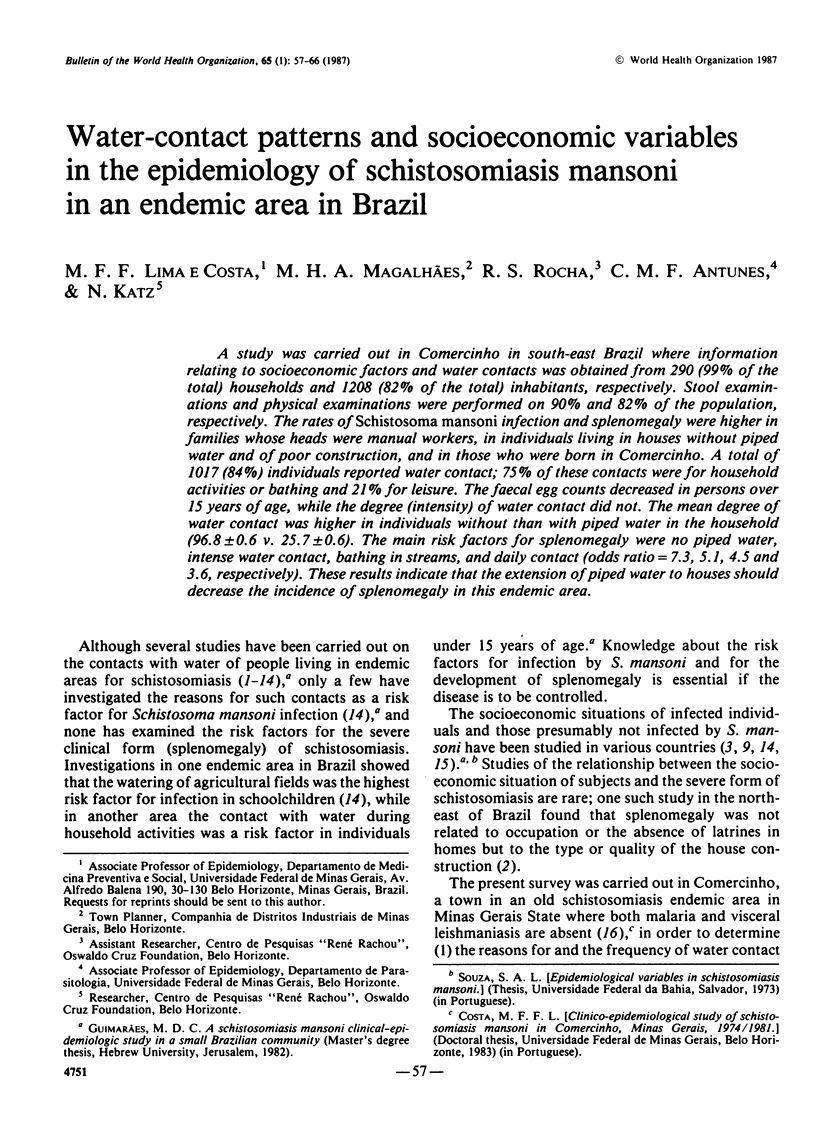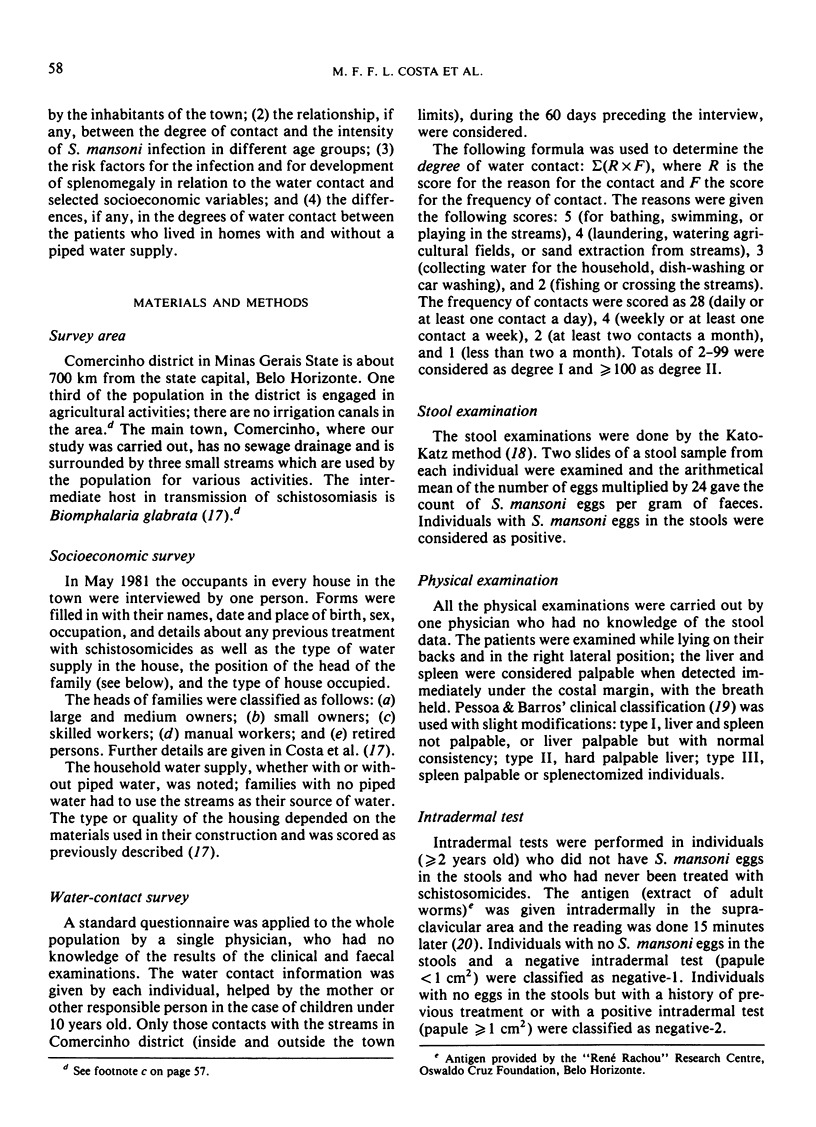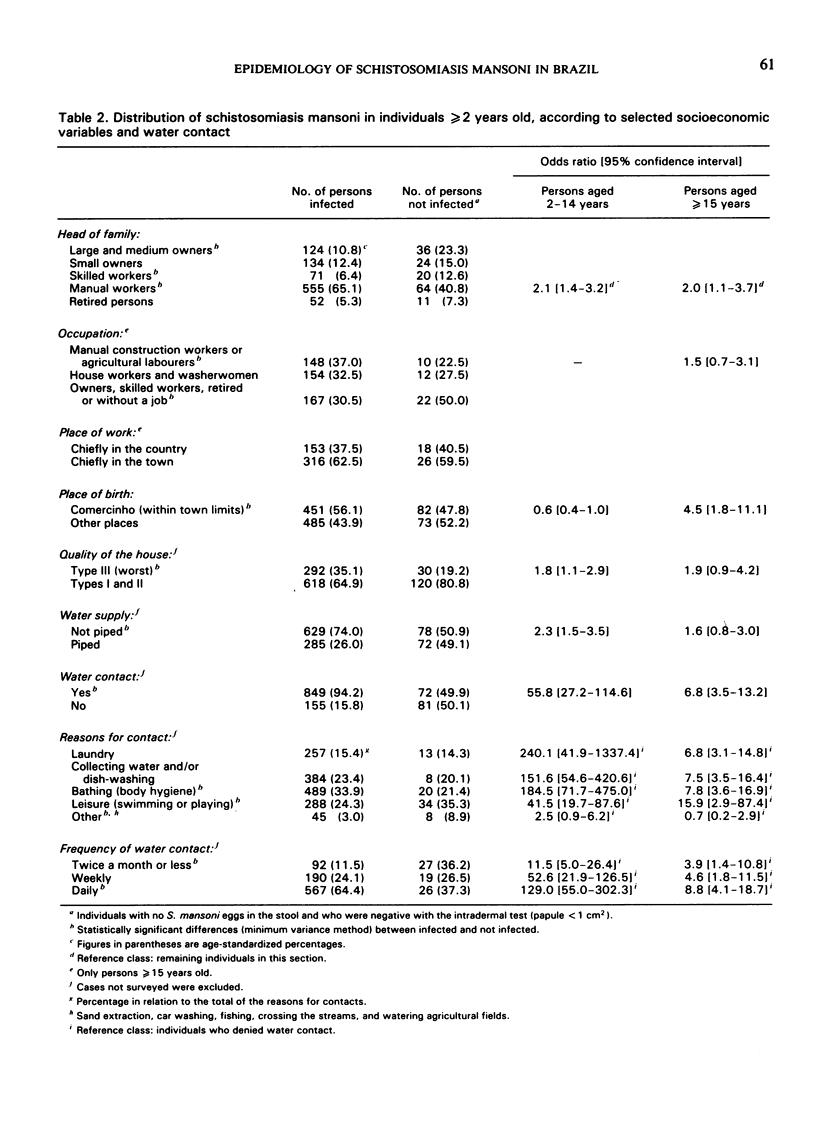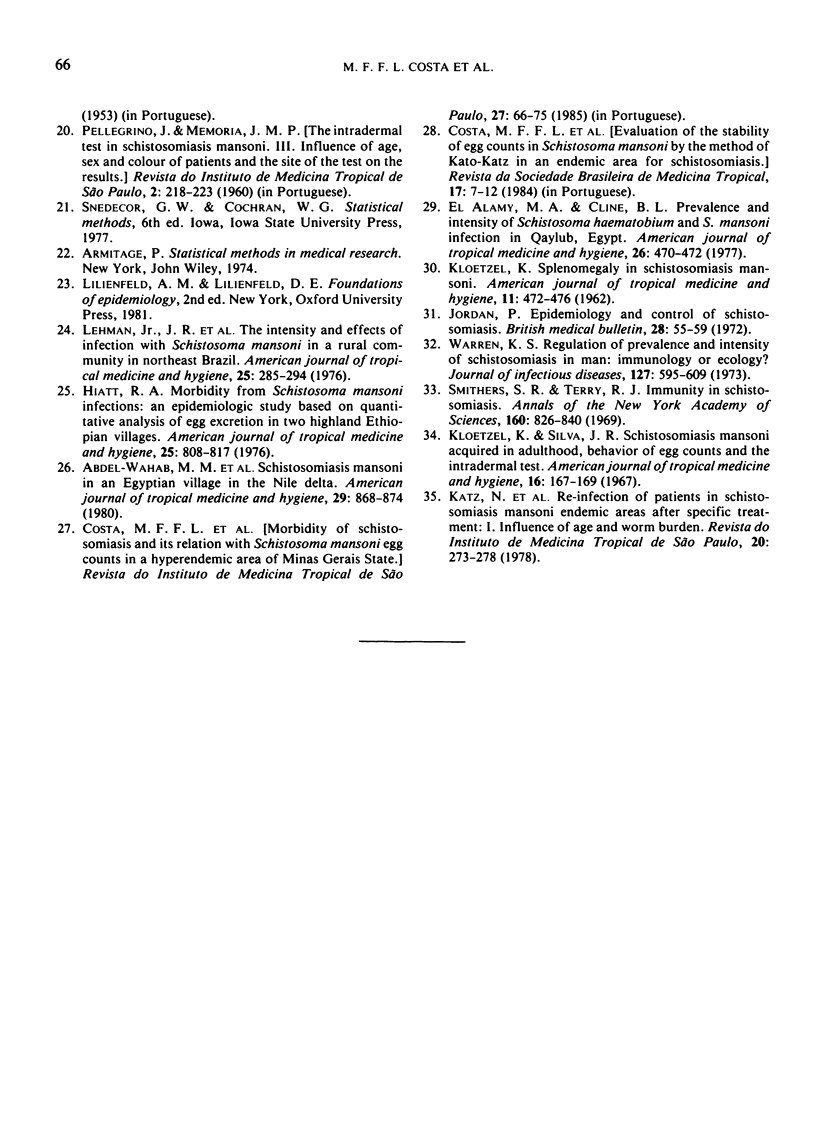Abstract
A study was carried out in Comercinho in south-east Brazil where information relating to socioeconomic factors and water contacts was obtained from 290 (99% of the total) households and 1208 (82% of the total) inhabitants, respectively. Stool examinations and physical examinations were performed on 90% and 82% of the population, respectively. The rates of Schistosoma mansoni infection and splenomegaly were higher in families whose heads were manual workers, in individuals living in houses without piped water and of poor construction, and in those who were born in Comercinho. A total of 1017 (84%) individuals reported water contact; 75% of these contacts were for household activities or bathing and 21% for leisure. The faecal egg counts decreased in persons over 15 years of age, while the degree (intensity) of water contact did not. The mean degree of water contact was higher in individuals without than with piped water in the household (96.8±0.6 v. 25.7±0.6). The main risk factors for splenomegaly weer no piped water, intense water contact, bathing in streams, and daily contact (odds ratio=7.3, 5.1, 4.5 and 3.6, respectively). These results indicate that the extension of piped water to houses should decrease the incidence of splenomegaly in this endemic area.
Full text
PDF









Selected References
These references are in PubMed. This may not be the complete list of references from this article.
- Abdel-Wahab M. F., Strickland G. T., El-Sahly A., Ahmed L., Zakaria S., El Kady N., Mahmoud S. Schistosomiasis mansoni in an Egyptian village in the Nile Delta. Am J Trop Med Hyg. 1980 Sep;29(5):868–874. doi: 10.4269/ajtmh.1980.29.868. [DOI] [PubMed] [Google Scholar]
- Dalton P. R. A socioecological approach to the control of Schistosoma mansoni in St Lucia. Bull World Health Organ. 1976;54(5):587–595. [PMC free article] [PubMed] [Google Scholar]
- Dalton P. R., Pole D. Water-contact patterns in relation to Schistosoma haematobium infection. Bull World Health Organ. 1978;56(3):417–426. [PMC free article] [PubMed] [Google Scholar]
- El Alamy M. A., Cline B. L. Prevalence and intensity of Schistosoma haematobium and S. mansoni infection in Qalyub, Egypt. Am J Trop Med Hyg. 1977 May;26(3):470–472. doi: 10.4269/ajtmh.1977.26.470. [DOI] [PubMed] [Google Scholar]
- Farooq M., Mallah M. B. The behavioural pattern of social and religious water-contact activities in the Egypt-49 bilharziasis project area. Bull World Health Organ. 1966;35(3):377–387. [PMC free article] [PubMed] [Google Scholar]
- Farooq M., Nielsen J., Samaan S. A., Mallah M. B., Allam A. A. The epidemiology of Schistosoma haematobium and S. mansoni infections in the Egypt-49 project area. 2. Prevalence of bilharziasis in relation to personal attributes and habits. Bull World Health Organ. 1966;35(3):293–318. [PMC free article] [PubMed] [Google Scholar]
- Farooq M., Nielsen J., Samaan S. A., Mallah M. B., Allam A. A. The epidemiology of Schistosoma haematobium and S. mansoni infections in the Egypt-49 project area. 3. Prevalence of bilharziasis in relation to certain environmental factors. Bull World Health Organ. 1966;35(3):319–330. [PMC free article] [PubMed] [Google Scholar]
- Fenwick A., Cheesmond A. K., Kardaman M., Amin M. A., Manjing B. K. Schistosomiasis among labouring communities in the Gezira irrigated area, Sudan. J Trop Med Hyg. 1982 Feb;85(1):3–11. [PubMed] [Google Scholar]
- Hiatt R. A., Cline B. L., Ruiz-Tiben E., Knight W. B., Berrios-Duran L. A. The Boqueron Project after 5 years: a prospective community-based study of infection with Schistosoma mansoni in Puerto Rico. Am J Trop Med Hyg. 1980 Nov;29(6):1228–1240. doi: 10.4269/ajtmh.1980.29.1228. [DOI] [PubMed] [Google Scholar]
- Hiatt R. A. Morbidity from Schistosoma mansoni infections: an epidemiologic study based on quantitative analysis of egg excretion in two highland Ethiopian villages. Am J Trop Med Hyg. 1976 Nov;25(6):808–817. doi: 10.4269/ajtmh.1976.25.808. [DOI] [PubMed] [Google Scholar]
- Husting E. L. Human water contact activities related to the transmission of bilharziasis (schistosomiasis). J Trop Med Hyg. 1983 Feb;86(1):23–35. [PubMed] [Google Scholar]
- Jobin W. R., Ruiz-Tiben E. Bilharzia and patterns of human contact with water in Puerto Rico. Bol Asoc Med P R. 1968 Jun;60(6):279–284. [PubMed] [Google Scholar]
- Jordan P., Christie J. D., Unrau G. O. Schistosomiasis transmission with particular reference to possible ecological and biological methods of control. A review. Acta Trop. 1980 Jun;37(2):95–135. [PubMed] [Google Scholar]
- Jordan P. Epidemiology and control of schistosomiasis. Br Med Bull. 1972 Jan;28(1):55–59. doi: 10.1093/oxfordjournals.bmb.a070894. [DOI] [PubMed] [Google Scholar]
- Katz N., Chaves A., Pellegrino J. A simple device for quantitative stool thick-smear technique in Schistosomiasis mansoni. Rev Inst Med Trop Sao Paulo. 1972 Nov-Dec;14(6):397–400. [PubMed] [Google Scholar]
- Katz N., Zicker F., Rocha R. S., Oliveira V. B. Re-infection of patients in schistosomiasis mansoni endemic areas after specific treatment. I--influence of age and worm burden. Rev Inst Med Trop Sao Paulo. 1978 Sep-Oct;20(5):273–278. [PubMed] [Google Scholar]
- Kloetzel K., da Silva J. R. Schistosomiasis mansoni acquired in adulthood: behavior of egg counts and the intradermal test. Am J Trop Med Hyg. 1967 Mar;16(2):167–169. doi: 10.4269/ajtmh.1967.16.167. [DOI] [PubMed] [Google Scholar]
- Lehman J. S., Jr, Mott K. E., Morrow R. H., Jr, Muniz T. M., Boyer M. H. The intensity and effects of infection with Schistosoma mansoni in a rural community in northeast Brazil. Am J Trop Med Hyg. 1976 Mar;25(2):285–294. doi: 10.4269/ajtmh.1976.25.285. [DOI] [PubMed] [Google Scholar]
- Lipes J. K., Hiatt R. A. Determinants of human water contact patterns in urban Puerto Rico with special reference to schistosomiasis. Bol Asoc Med P R. 1977 Feb;69(2):35–44. [PubMed] [Google Scholar]
- PIMENTEL D., GERHARDT C. E., WILLIAMS E. R., WHITE P. C., Jr, FERGUSON F. F. Aspects of schistosomal endemicity in three Puerto Rican watersheds. Am J Trop Med Hyg. 1961 Jul;10:523–529. doi: 10.4269/ajtmh.1961.10.523. [DOI] [PubMed] [Google Scholar]
- Tayo M. A., Pugh R. N., Bradley A. K. Malumfashi Endemic Diseases Research Project, XI. Water-contact activities in the schistosomiasis study area. Ann Trop Med Parasitol. 1980 Jun;74(3):347–354. doi: 10.1080/00034983.1980.11687351. [DOI] [PubMed] [Google Scholar]
- Warren K. S. Regulation of the prevalence and intensity of schistosomiasis in man: immunology or ecology? J Infect Dis. 1973 May;127(5):595–609. doi: 10.1093/infdis/127.5.595. [DOI] [PubMed] [Google Scholar]


